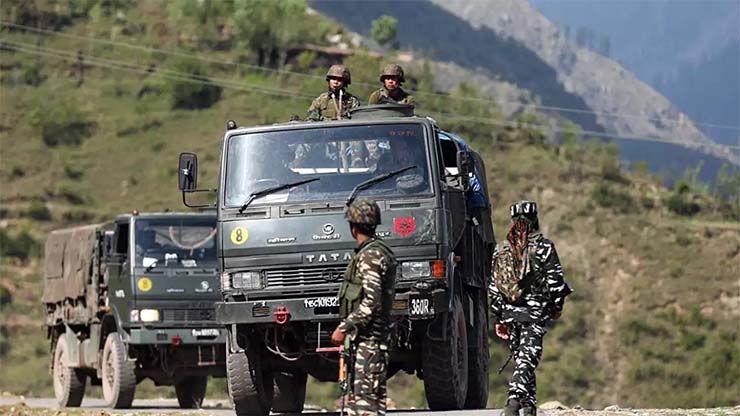
New Delhi: With the country continuing to face aggressive postures by its neighbours on its Northern and Western borders – China and Pakistan – respectively, it becomes imperative for rapidly boosting the technology available with the armed forces to guard the borders and specially the Army who almost 24X7 are on alert.
In keeping with this scenario, work is on to have in place by December 2025 the Battlefield Surveillance System (BSS) to enable Army commanders get real-time, comprehensive operational picture through automation initiatives. This would enable the Commanders at all levels to keep tabs on the border using the latest technology and ensure that timely measures are taken to deter the adversary from making any moves threatening the nation’s security.
Keeping this in focus, the BSS will have information and data from various sensors and input sources — including those from across the border — into one comprehensive image, to enable Army Commanders in quick decision-making. The BSS called ‘Project Sanjay’ is in the process of being deployed after extensive validation carried out in plains, desert and mountainous regions. Once in place, the BSS will help Army formations at all levels have a real-time, common operating picture, with information and data from various sensors and inputs fused into one comprehensive image for quick decision-making. The project platform’s design has been inspired by Prime Minister’s Gati Shakti, with the Army building a similar project which will bring a multi-domain spatial awareness on a single platform.
“Under BSS, the aim is to have surveillance centres for all field formations by December 2025. It will integrate thousands of sensors which will enable provision of an integrated surveillance picture to commanders and staff at all levels, besides completing the sensor-shooter grid by integrating with the Artillery Combat Command and Control System (ACCCS),” defence sources told media. The system also integrates data on the movements of India’s adversaries received from various sources across borders, including sensors, satellites, UAVs or unmanned aerial vehicles, and patrols.
Taken together, it would boost battlefield awareness for commanders on the ground, and also provide functional efficiency for human resource management, logistics, inventory management, medical services and other administrative functions, sources said.
The Public Sector Undertaking Bharat Electronics Limited (BEL) Ghaziabad is the project’s system integrator, and after hundreds of trials across terrains, it has shown a rate of success of more than 95%, meeting the army’s aspirations and requirements. The original cost was estimated to be around Rs 2,700 crore, but has now been revised to Rs 2,400 crore and is set to go down further.
The system will be first operationalised in the Army’s Northern Command in June 2023 and the balance commands will migrate to the new system later. The Army has also tied up with National Centre for Medium Range Weather Forecasting to help the artillery fire more accurately using meteorological inputs. With information and intelligence becoming a key factor in wars, the new battle management system becomes all the more imperative and for this the Army has also invested in captive data centres in the country and acquired substantial capability to host applications.
The data centres will be fully operational by this year, according to sources said. They said the Army’s Combat Information Decision Support System (CIDSS) has been re-designed as the Army Information and Decision Support System (AIDSS), which will integrate inputs from all operational and managerial information systems.
In the interim, the Army has developed an in-house decision support system called the Situational Awareness Module for the Army (SAMA). The application has been designed to present the comprehensive battlefield picture to commanders at all levels based on authorisation and roles. SAMA has been developed in cooperation with the Bhaskaracharya Institute for Space Applications and Geoinformatics has successfully integrated inputs from ACCCS, BSS, e-Sitrep, and the Management Information Systems Organisation. The application has been designed to present a comprehensive battlefield picture to commanders at all levels based on authorisation and roles, the source said.
SAMA is being fielded this month for validation in a corps zone. Sources said the idea is to cut down the decision-making process for a commander. “He [a commander] is able to get the entire information on one screen and he can fine-tune the dashboard as per his wish and priority area. He can also give instructions through the app,” a source said. Situational reporting is the keystone of all operational correspondence that happens on a perpetual basis, and this is the lifeblood that keeps the operational staff working. While this workflow has matured over the years, over the past few months it has undergone a major transformation.
“Commencing June this year, the situational reporting would start happening on an enterprise-class GIS platform configured for the Army’s operational needs, with a state-of-the-art spatial visualisation, temporal and dynamic querying and analytics custom-built for commanders and staff according to authorisation rules,” sources said.
The Army has also tied up with the National Centre for Medium Range Weather Forecasting (NCMRWF) for helping the artillery fire more accurately. This collaboration has led to the development of an application called ‘Anumaan’. Meteorological inputs are of great significance to commanders in the field. The artillery unit uses them on a regular basis to temper its weapon platforms before firing projectiles through the Earth’s atmosphere.
Also, inspired by the Prime Minister’s Gati Shakti programme, the Army has emulated the platform’s design and has begun its own initiative to build a similar project that will bring in multi-domain spatial awareness on a single GIS platform. The concept will be operationalised in a phased manner and in the first phase the project named ‘Avagat’ will bring together inputs from the operational domain, logistic inputs of selected nature, satellite imagery data, topographic and metrological inputs on a common platform and the system is expected to be fully operational towards the year-end, sources said.









